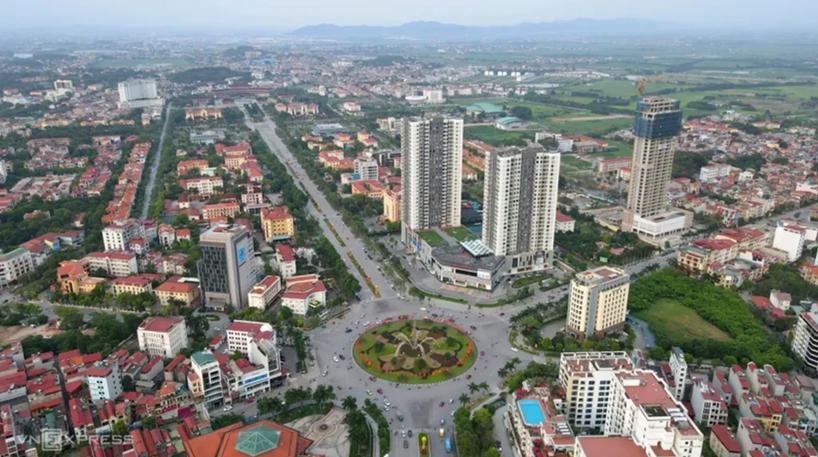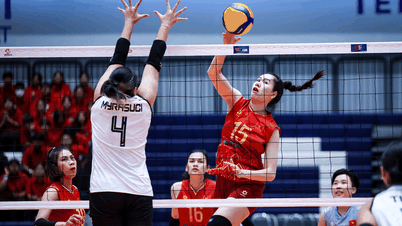 |
| A corner of Bac Ninh city. Illustrative photo: VNA |
In Resolution No. 1654/NQ-UBTVQH15, the National Assembly Standing Committee resolved to rearrange commune-level administrative units of An Giang province. After the rearrangement, An Giang province has 102 commune-level administrative units, including 85 communes, 14 wards and 3 special zones; of which 79 communes, 14 wards, 3 special zones were formed after the rearrangement and 6 communes did not undergo the rearrangement, namely My Hoa Hung, Binh Giang, Binh Son, Hon Nghe, Son Hai, Tien Hai.
In Resolution No. 1658/NQ-UBTVQH15, the National Assembly Standing Committee resolved to rearrange commune-level administrative units of Bac Ninh province. After the rearrangement, Bac Ninh province has 99 commune-level administrative units, including 66 communes and 33 wards; of which 65 communes and 33 wards were formed after the rearrangement and 1 commune that did not undergo the rearrangement, Tuan Dao commune.
In Resolution No. 1655/NQ-UBTVQH15, the National Assembly Standing Committee resolved to rearrange commune-level administrative units of Ca Mau province. After the rearrangement, Ca Mau province has 64 commune-level administrative units, including 55 communes and 9 wards; of which 54 communes, 09 wards were formed after the rearrangement and 1 commune that did not undergo the rearrangement, Ho Thi Ky commune.
In Resolution No. 1668/NQ-UBTVQH15, the National Assembly Standing Committee resolved to rearrange the commune-level administrative units of Can Tho city. After the rearrangement, Can Tho city has 103 commune-level administrative units, including 31 wards and 72 communes; of which 30 wards and 65 communes were formed after the rearrangement and 8 commune-level administrative units were not rearranged, namely Tan Loc ward, Truong Long, Thanh Phu, Thoi Hung, Phong Nam, My Phuoc, Lai Hoa, Vinh Hai communes.
In Resolution No. 1657/NQ-UBTVQH15, the National Assembly Standing Committee resolved to rearrange commune-level administrative units of Cao Bang province. After the rearrangement, Cao Bang province has 56 commune-level administrative units, including 53 communes and 3 wards.
In Resolution No. 1659/NQ-UBTVQH15, the National Assembly Standing Committee resolved to rearrange the commune-level administrative units of Da Nang city. After the rearrangement, Da Nang city has 94 commune-level administrative units, including 23 wards, 70 communes, 1 special zone; of which 23 wards, 68 communes, 1 special zone were formed after the rearrangement and 2 communes did not undergo the rearrangement, namely Tam Hai commune and Tan Hiep commune.
In Resolution No. 1660/NQ-UBTVQH15, the National Assembly Standing Committee resolved to rearrange commune-level administrative units of Dak Lak province. After the rearrangement, Dak Lak province has 102 commune-level administrative units, including 88 communes and 14 wards; of which 82 communes and 14 wards were formed after the rearrangement, implementing the name change regulations and 6 communes that did not implement the rearrangement are Ea H'Leo, Ea Trang, Ia Lop, Ia Rve, Krong No, Vu Bon.
In Resolution No. 1661/NQ-UBTVQH15, the National Assembly Standing Committee resolved to rearrange commune-level administrative units of Dien Bien province. After the rearrangement, Dien Bien province has 45 commune-level administrative units, including 42 communes and 3 wards.
In Resolution No. 1662/NQ-UBTVQH15, the National Assembly Standing Committee resolved to rearrange commune-level administrative units of Dong Nai province. After the rearrangement, Dong Nai province has 95 commune-level administrative units, including 72 communes and 23 wards; of which 67 communes and 21 wards were formed after the rearrangement and 7 commune-level administrative units were not rearranged, namely Phuoc Tan ward, Tam Phuoc ward, Thanh Son communes (Dinh Quan district), Dak Lua, Phu Ly, Bu Gia Map, Dak O.
In Resolution No. 1663/NQ-UBTVQH15, the National Assembly Standing Committee resolved to rearrange commune-level administrative units of Dong Thap province. After the rearrangement, Dong Thap province has 102 commune-level administrative units, including 82 communes and 20 wards.
In Resolution No. 1664/NQ-UBTVQH15, the National Assembly Standing Committee resolved to rearrange commune-level administrative units of Gia Lai province. After the rearrangement, Gia Lai province has 135 commune-level administrative units, including 110 communes and 25 wards; of which 101 communes and 25 wards were formed after the rearrangement and 9 communes were not rearranged, namely Ia O commune (Ia Grai district), Nhon Chau, Ia Puch, Ia Mo, Ia Pnôn, Ia Nan, Ia Dom, Ia Chia and Krong.
In Resolution No. 1656/NQ-UBTVQH15, the National Assembly Standing Committee resolved to rearrange the commune-level administrative units of Hanoi city. After the rearrangement, Hanoi city has 126 commune-level administrative units, including 51 wards and 75 communes.
In Resolution No. 1665/NQ-UBTVQH15, the National Assembly Standing Committee resolved to rearrange commune-level administrative units of Ha Tinh province. After the rearrangement, Ha Tinh province has 69 commune-level administrative units, including 60 communes and 9 wards; of which 58 communes and 9 wards were formed after the rearrangement and 2 communes that did not undergo the rearrangement, namely Son Kim 1 commune and Son Kim 2 commune.
In Resolution No. 1669/NQ-UBTVQH15, the National Assembly Standing Committee resolved to rearrange the commune-level administrative units of Hai Phong city. After the rearrangement, Hai Phong city has 114 commune-level administrative units, including 67 communes, 45 wards and 2 special zones.
In Resolution No. 1666/NQ-UBTVQH15, the National Assembly Standing Committee resolved to rearrange commune-level administrative units of Hung Yen province. After the rearrangement, Hung Yen province has 104 commune-level administrative units, including 93 communes and 11 wards.
In Resolution No. 1675/NQ-UBTVQH15, the National Assembly Standing Committee resolved to rearrange the commune-level administrative units of Hue city. After the rearrangement, Hue city has 40 commune-level administrative units, including 21 wards and 19 communes; of which 20 wards and 19 communes were formed after the rearrangement and 1 ward that did not undergo the rearrangement, Duong No ward.
In Resolution No. 1667/NQ-UBTVQH15, the National Assembly Standing Committee resolved to rearrange commune-level administrative units of Khanh Hoa province. After the rearrangement, Khanh Hoa province has 65 commune-level administrative units, including 48 communes, 16 wards and 1 special zone.
In Resolution No. 1670/NQ-UBTVQH15, the National Assembly Standing Committee resolved to rearrange commune-level administrative units of Lai Chau province. After the rearrangement, Lai Chau province has 38 commune-level administrative units, including 36 communes and 2 wards; of which 34 communes and 2 wards were formed after the rearrangement and 2 communes did not undergo the rearrangement, namely Mu Ca commune and Ta Tong commune.
In Resolution No. 1671/NQ-UBTVQH15, the National Assembly Standing Committee resolved to rearrange commune-level administrative units of Lam Dong province. After the rearrangement, Lam Dong province has 124 commune-level administrative units, including 103 communes, 20 wards, and 1 special zone; of which 99 communes, 20 wards, and 1 special zone were formed after the rearrangement, implementing the name change regulations, and 4 communes that did not implement the rearrangement are Quang Hoa, Quang Son, Quang Truc, and Ninh Gia communes.
In Resolution No. 1672/NQ-UBTVQH15, the National Assembly Standing Committee resolved to rearrange the commune-level administrative units of Lang Son province. After the rearrangement, Lang Son province has 65 commune-level administrative units, including 61 communes and 4 wards.
In Resolution No. 1673/NQ-UBTVQH15, the National Assembly Standing Committee resolved to rearrange commune-level administrative units of Lao Cai province. After the rearrangement, Lao Cai province has 99 commune-level administrative units, including 89 communes and 10 wards; of which 81 communes and 10 wards were formed after the rearrangement and 8 communes were not rearranged, namely Nam Xe, Ngu Chi Son, Che Tao, Lao Chai, Nam Co, Ta Xi Lang, Cat Thinh, Phong Du Thuong.
In Resolution No. 1678/NQ-UBTVQH15, the National Assembly Standing Committee resolved to rearrange commune-level administrative units of Nghe An province. After the rearrangement, Nghe An province has 130 commune-level administrative units, including 119 communes and 11 wards; of which 110 communes and 11 wards were formed after the rearrangement and 9 communes were not rearranged, namely Keng Du, My Ly, Bac Ly, Huoi Tu, Muong Long, Binh Chuan, Huu Khuong, Luong Minh, Chau Binh.
In Resolution No. 1674/NQ-UBTVQH15, the National Assembly Standing Committee resolved to rearrange commune-level administrative units of Ninh Binh province. After the rearrangement, Ninh Binh province has 129 commune-level administrative units including 97 communes and 32 wards.
In Resolution No. 1676/NQ-UBTVQH15, the National Assembly Standing Committee resolved to rearrange commune-level administrative units of Phu Tho province. After the rearrangement, Phu Tho province has 148 commune-level administrative units, including 133 communes and 15 wards; of which 131 communes and 15 wards were formed after the rearrangement and 2 communes that did not undergo the rearrangement, namely Thu Cuc commune and Trung Son commune.
In Resolution No. 1677/NQ-UBTVQH15, the National Assembly Standing Committee resolved to rearrange commune-level administrative units of Quang Ngai province. After the rearrangement, Quang Ngai province has 96 commune-level administrative units, including 86 communes, 9 wards and 1 special zone; of which 81 communes, 9 wards, 1 special zone were formed after the rearrangement and 5 communes were not rearranged, namely Dak Long commune (Dak Glei district), Ba Xa, Ro Koi, Mo Rai, Ia Dal.
In Resolution No. 1679/NQ-UBTVQH15, the National Assembly Standing Committee resolved to rearrange commune-level administrative units of Quang Ninh province. After the rearrangement, Quang Ninh province has 54 commune-level administrative units, including 22 communes, 30 wards and 2 special zones; of which 21 communes, 30 wards, 2 special zones were formed after the rearrangement and 1 commune that did not undergo the rearrangement, Cai Chien commune.
In Resolution No. 1680/NQ-UBTVQH15, the National Assembly Standing Committee resolved to rearrange commune-level administrative units of Quang Tri province. After the rearrangement, Quang Tri province has 78 commune-level administrative units, including 69 communes, 8 wards and 1 special zone; of which 68 communes, 8 wards, 1 special zone were formed after the rearrangement and 1 commune did not undergo the rearrangement, which is Tan Thanh commune (Minh Hoa district).
In Resolution No. 1681/NQ-UBTVQH15, the National Assembly Standing Committee resolved to rearrange commune-level administrative units of Son La province. After the rearrangement, Son La province has 75 commune-level administrative units, including 67 communes and 8 wards; of which 60 communes and 8 wards were formed after the rearrangement and 7 communes were not rearranged, namely Muong Lan, Phieng Khoai, Suoi To, Ngoc Chien, Tan Yen, Muong Bam, and Muong Leo.
In Resolution No. 1682/NQ-UBTVQH15, the National Assembly Standing Committee resolved to rearrange the commune-level administrative units of Tay Ninh province. After the rearrangement, Tay Ninh province has 96 commune-level administrative units, including 82 communes and 14 wards.
In Resolution No. 1683/NQ-UBTVQH15, the National Assembly Standing Committee resolved to rearrange commune-level administrative units of Thai Nguyen province. After the rearrangement, Thai Nguyen province has 92 commune-level administrative units, including 77 communes and 15 wards; of which 75 communes and 15 wards were formed after the rearrangement and 2 communes were not rearranged, namely Sang Moc commune and Thuong Quan commune.
In Resolution No. 1686/NQ-UBTVQH15, the National Assembly Standing Committee resolved to rearrange commune-level administrative units of Thanh Hoa province. After the rearrangement, Thanh Hoa province has 166 commune-level administrative units, including 147 communes and 19 wards; of which 126 communes and 19 wards were formed after the rearrangement and 21 communes did not undergo the rearrangement, namely Phu Xuan commune (Quan Hoa district), Muong Chanh, Quang Chieu, Tam Chung, Pu Nhi, Nhi Son, Muong Ly, Trung Ly, Trung Son, Na Meo, Son Thuy, Son Dien, Muong Min, Tam Thanh, Yen Khuong, Yen Thang, Xuan Thai, Bat Mot, Yen Nhan, Luong Son, and Van Xuan.
In Resolution No. 1685/NQ-UBTVQH15, the National Assembly Standing Committee resolved to rearrange the commune-level administrative units of Ho Chi Minh City. After the rearrangement, Ho Chi Minh City has 168 commune-level administrative units, including 113 wards, 54 communes and 1 special zone; of which 112 wards, 50 communes, 1 special zone were formed after the rearrangement and 5 commune-level administrative units were not rearranged, namely Thoi Hoa ward, Long Son, Hoa Hiep, Binh Chau, Thanh An communes.
In Resolution No. 1684/NQ-UBTVQH15, the National Assembly Standing Committee resolved to rearrange commune-level administrative units of Tuyen Quang province. After the rearrangement, Tuyen Quang province has 124 commune-level administrative units, including 117 communes and 7 wards; of which 104 communes and 7 wards were formed after the rearrangement and 13 communes were not rearranged, namely Trung Ha, Kien Thiet, Hung Duc, Minh Son, Minh Tan, Thuan Hoa, Tung Ba, Thuong Son, Cao Bo, Ngoc Long, Giap Trung, Tien Nguyen, and Quang Nguyen.
In Resolution No. 1687/NQ-UBTVQH15, the National Assembly Standing Committee resolved to rearrange commune-level administrative units of Vinh Long province. After the rearrangement, Vinh Long province has 124 commune-level administrative units, including 105 communes and 19 wards; of which 101 communes and 19 wards were formed after the rearrangement and 4 communes that did not undergo the rearrangement were Long Hoa commune (Chau Thanh district), Dong Hai, Long Vinh, and Hoa Minh.
The above Resolutions take effect from the date of approval (June 16, 2025).
Competent authorities shall urgently carry out necessary preparations to ensure that local authorities in commune-level administrative units formed after the reorganization officially operate from July 1, 2025.
Source: https://huengaynay.vn/chinh-tri-xa-hoi/theo-dong-thoi-su/nghi-quyet-cua-uy-ban-thuong-vu-quoc-hoi-ve-sap-xep-cac-don-vi-hanh-chinh-cap-xa-154789.html




































































































Comment (0)